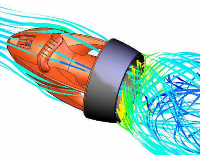 | ||
Mod 01 lec 41 introduction to turbulence modeling
Turbulence modeling is the construction and use of a model to predict the effects of turbulence. A turbulent fluid flow has features on many different length scales, which all interact with each other. A common approach is to average the governing equations of the flow, in order to focus on large-scale and non-fluctuating features of the flow. However, the effects of the small scales and fluctuating parts must be modelled.
Contents
- Mod 01 lec 41 introduction to turbulence modeling
- Introduction to turbulence turbulence modeling
- Closure problem
- Eddy viscosity
- Prandtls mixing length concept
- Smagorinsky model for the sub grid scale eddy viscosity
- SpalartAllmaras k and k models
- Common models
- References
Introduction to turbulence turbulence modeling
Closure problem
The Navier–Stokes equations govern the velocity and pressure of a fluid flow. In a turbulent flow, each of these quantities may be decomposed into a mean part and a fluctuating part. Averaging the equations gives the Reynolds-averaged Navier–Stokes (RANS) equations, which govern the mean flow. However, the nonlinearity of the Navier–Stokes equations means that the velocity fluctuations still appear in the RANS equations, in the nonlinear term
To obtain equations containing only the mean velocity and pressure, we need to close the RANS equations by modelling the Reynolds stress term
Eddy viscosity
Joseph Valentin Boussinesq was the first to attack the closure problem, by introducing the concept of eddy viscosity. In 1877 Boussinesq proposed relating the turbulence stresses to the mean flow to close the system of equations. Here the Boussinesq hypothesis is applied to model the Reynolds stress term. Note that a new proportionality constant
In this model, the additional turbulence stresses are given by augmenting the molecular viscosity with an eddy viscosity. This can be a simple constant eddy viscosity (which works well for some free shear flows such as axisymmetric jets, 2-D jets, and mixing layers).
Prandtl's mixing-length concept
Later, Ludwig Prandtl introduced the additional concept of the mixing length, along with the idea of a boundary layer. For wall-bounded turbulent flows, the eddy viscosity must vary with distance from the wall, hence the addition of the concept of a 'mixing length'. In the simplest wall-bounded flow model, the eddy viscosity is given by the equation:
This simple model is the basis for the "law of the wall", which is a surprisingly accurate model for wall-bounded, attached (not separated) flow fields with small pressure gradients.
More general turbulence models have evolved over time, with most modern turbulence models given by field equations similar to the Navier-Stokes equations.
Smagorinsky model for the sub-grid scale eddy viscosity
Among many others, Joseph Smagorinsky (1964) proposed a useful formula for the eddy viscosity in numerical models, based on the local derivatives of the velocity field and the local grid size:
Spalart–Allmaras, k–ε and k–ω models
The Boussinesq hypothesis is employed in the Spalart–Allmaras (S–A), k–ε (k–epsilon), and k–ω (k–omega) models and offers a relatively low cost computation for the turbulence viscosity
Common models
The following is a brief overview of commonly employed models in modern engineering applications.
